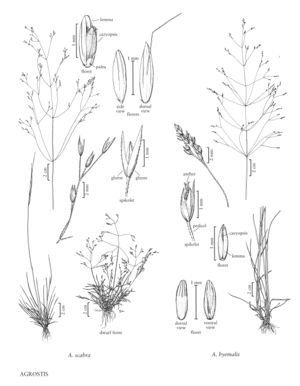Agrostis scabra
Plants perennial or annual; cespitose, not rhizomatous or stoloniferous. Culms (7.5) 15-90 cm, erect, nodes usually 1-3. Leaves mostly basal, basal leaves usually persistent; sheaths usually smooth, sometimes scabridulous; ligules 0.7-5 mm, dorsal surfaces scabrous, apices usually rounded, sometimes truncate or acute, erose-ciliolate, sometimes lacerate; blades 4-14 cm long, 1-2 mm wide, basal blades mostly involute, cauline blades mostly flat. Panicles (4)8-25(50) cm long, 0.5-20 cm wide, broadly ovate, often nearly as wide as long, diffuse, the whole panicle often detaching at the base at maturity, forming a tumbleweed, exserted from the upper sheaths, lowest node with (1)2-7(12) branches; branches scabrous, capillary, flexible, wide-spreading, readily visible, branching beyond midlength, spikelets somewhat distant, not crowded, lower branches 4-12 cm; pedicels 0.4-9.6 mm. Spikelets lanceolate, greenish purple, frequently purple at maturity. Glumes unequal, 1.8-3.4 mm, lanceolate, 1-veined, keels scabrous at least towards the apices, apices acuminate; callus hairs to 0.2 mm, sparse; lemmas 1.4-2 mm, scabrous to scabridulous or smooth, translucent to opaque, 5-veined, veins prominent, apices acute to obtuse, usually entire, sometimes minutely toothed, unawned or awned from below midlength, awns 0.2-3 mm, exceeding the lemma apices by up to 2.5 mm, geniculate or straight, persistent; paleas absent or to 0.2 mm; anthers 3, 0.4-0.8 mm, usually shed at anthesis. Caryopses 0.9-1.4 mm; endosperm liquid. 2n = 42.
Distribution
Conn., N.J., N.Y., Wash., Del., Wis., W.Va., Mass., Maine, N.H., R.I., Vt., Fla., Wyo., N.Mex., Tex., La., Tenn., Pa., Ark., Md., Mont., N.C., S.C., Va., Calif., Nev., Colo., Alaska, Ala., Ill., Ga., Ind., Iowa, Ariz., Idaho, N.Dak., Nebr., S.Dak., Alta., B.C., Greenland, Man., N.B., Nfld. and Labr., N.S., N.W.T., Nunavut, Ont., P.E.I., Que., Sask., Yukon, Ohio, Utah, Minn., Mich., Miss., Ky., Oreg.
Discussion
Agrostis scabra grows in a wide variety of habitats, including grasslands, meadows, shrublands, wood¬lands, marshes, and stream and lake margins, as well as disturbed sites such as roadsides, ditches, and aban¬doned pastures. It occurs throughout much of the Flora region, but is not common in the Canadian high arctic or the southeastern United States. It extends south into Mexico; it is also native to the Pacific coast from Kamchatka to Japan and Korea, and has been introduced elsewhere.
Plants in the Agrostis scabra aggregate are variable. Awned and unawned plants often occur together, the difference presumably being caused by a single gene. At least three groups may be distinguished within the species as treated here: widespread, lowland, rather weedy plants capable of producing very large panicles that have been introduced into the southern United States; smaller, short-leaved, slow-growing plants of rocks and screes, which are widespread in the Rockies, the Appalachians, and much of Alaska, Canada, and Greenland; and luxuriant, broad-leaved plants that are characteristically found in sheltered, frost-free canyons of the southwestern United States. The second group has sometimes been called A. scabra var. geminata (Trin.) Swallen or A. geminata Trin.
Tercek et al. (2003) found that annual forms of Agrostis scabra with inflated upper sheaths and open panicles that were collected around hot springs in western North America were molecularly, and in some respects morphologically, more similar to plants identified as hot spring endemics such as A. rossiae and A. pauzbetica Prob., than they were to neighboring perennial plants of A. scabra that did not have inflated leaf sheaths. They differed, however, in having open, rather than contracted, panicles.
Agrostis scabra is often confused with a number of other species; for comparisons, see under the appropriate species description: A. mertensii (p. 644), A. clavata (see previous), A. hyemalis (see next), A. perennans (see this page), and A. idahoensis (p. 649).
Selected References
None.
